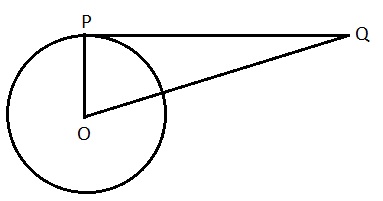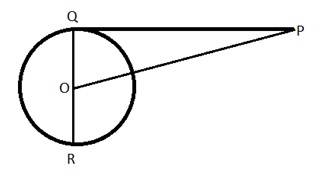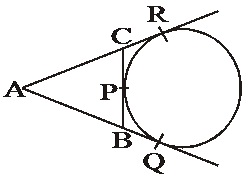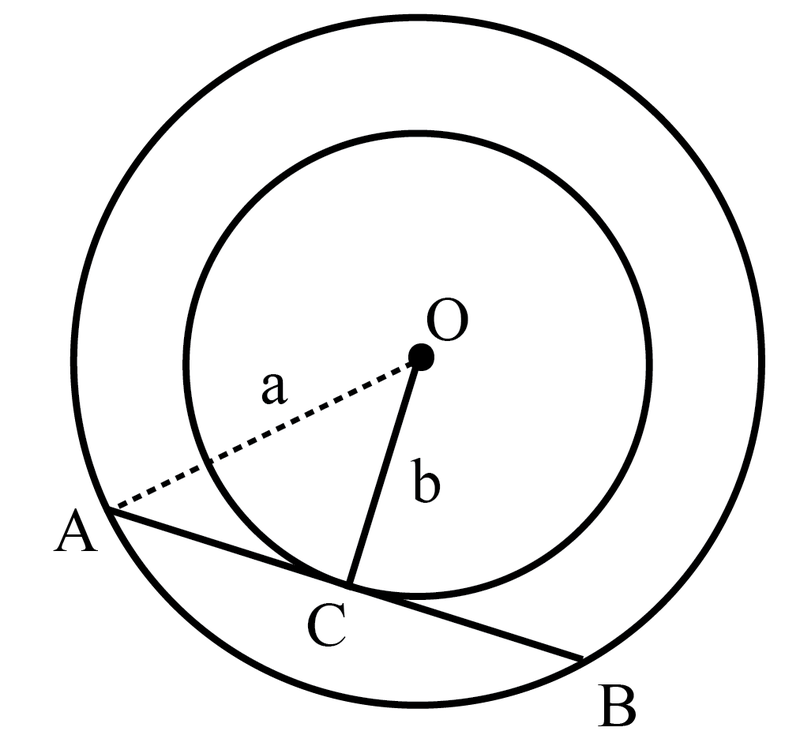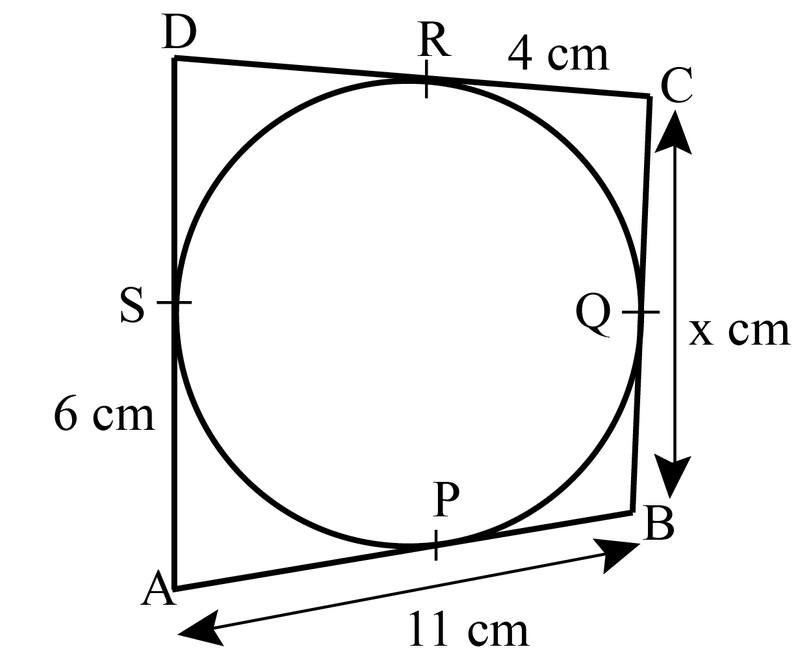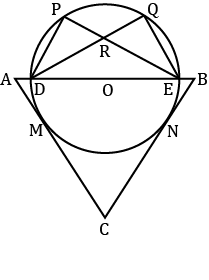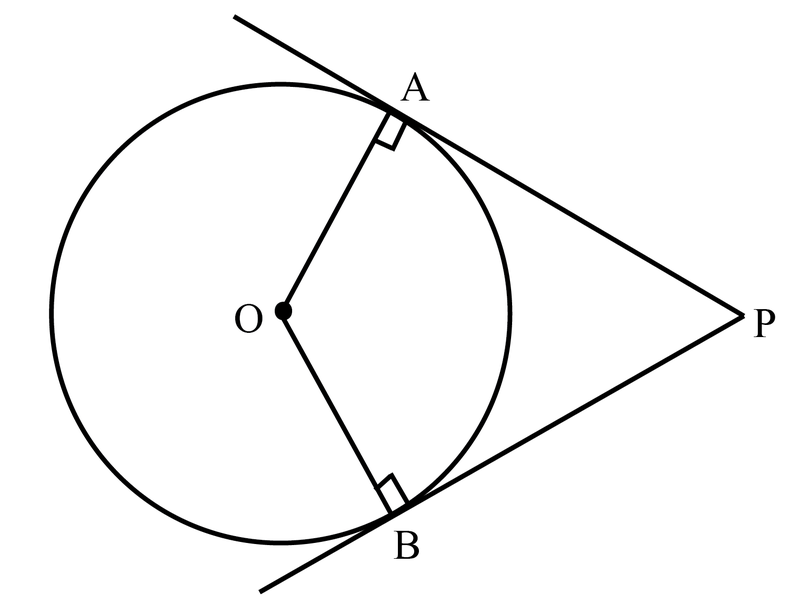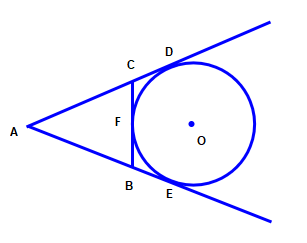10th Grade > Mathematics
CIRCLES MCQs
:
A
Consider the below figure wherein three circles touch each other externally.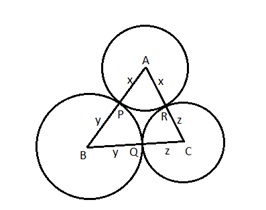
Since the distances between the centres of these circles are 5 cm, 6 cm and 7 cm respectively, we have the following set of equations with respect to the above diagram:
x+y = 5 …..(1)
y+z = 6 ......(2) (⇒ y=6-z)... (2.1)
x+z = 7 …..(3)
Adding (1), (2) and (3), we have 2(x+y+z)=5+6+7=18
⟹x+y+z=9....(4)
Using (1) in (4), we have 5+z=9⟹z=4
Now using, (3)⟹x=7−z=7−4=3
And (2.1)⟹y=6−z=6−4=2
Therefore, the radii of the circles are 3 cm, 2 cm and 4 cm.
:
We know that
AQ = AR
AQ = AC + CR
But CR = CP
Therefore AQ = AC + CP …..(i)
Also AQ = AB + BQ
But BQ = BP
∴ AQ = AB + BP .….(ii)
Adding equations (i) and (ii)
2AQ = AC + CP + BP + AB
2AQ = Perimeter of ΔABC
Perimeter of ΔABC = 2 × 15 = 30 cm
:
C
Let O be the common centre of the two circles and AB be the chord of the larger circle which touches the smaller circle at C.
Join OA and OC.
Then OC ⊥ AB
Let OA = a and OC = b.
Since OC ⊥ AB, OC bisects AB
[ ∵ perpendicular from the centre to a chord bisects the chord].
In right Δ ACO, we have
OA2=OC2+AC2 [by Pythagoras' theorem]
⇒ AC=√OA2−OC2=√a2−b2
∴ AB=2AC=2√a2−b2 [ ∵ C is the midpoint of AB]
i.e., Length of the chord AB=2√a2−b2
:
AP = AS = 6 cm
BP = BA – AP = 11 – 6 = 5
BQ = BP = 5
CQ = CR = 4
x = CQ + BQ
x = 4 + 5 = 9 cm
:
C
ADB is a straight line. By linear pair axiom,
∠ADP + ∠PDB = 180∘
100 + ∠PDB = 180∘
∠PDB = 80∘
Similarly ∠QED = 80∘
We have, ∠DPE = 90∘ (angle subtended by a diameter)
In △DPE,
∠DPE + ∠PED + ∠EDP = 180
[Angle sum property of a triangle]
∠PED = 10∘
Similarly ∠QDE = 10∘
In △DRE,
∠DRE + ∠RDE + ∠RED = 180
[Angle sum property of a triangle]
∠DRE = 160∘
PRE is a straight line. By linear pair axiom,
∠PRD + ∠DRE = 180∘
∠PRD + 160 = 180∘
∠PRD = 20∘
:
A
Given PA and PB are tangents to the circle with centre O from an external point P.
We know that the tangent at any point of a circle is perpendicular to radius at the point of contact.
∴ PA⊥OA, i.e., ∠OAP=90∘ . . . (i)
and PB⊥OB, i.e., ∠OBP=90∘ . .. (ii)
Now, the sum of all the angles of a quadrilateral is 360∘
∴ ∠AOB+∠OAP+∠APB+∠OBP=360∘
⇒ ∠AOB+∠APB=180∘ [using (i) and (ii)]
∴ quadrilateral OAPB is cyclic [since both pairs of opposite angles have the sum 180∘].
:
B
AD=AE
AD=AB+BE
Since BE=BF as tangents drawn from an external point to a circle are equal , AD=AB+BF……(1)
Also
AD=AC+CD
AD=AC+CF ……(2) (CD and CF are tangents drawn from the external point C to the circle)
Adding equation (1) and (2),
AD+AD=AB+BF+CF+AC
2AD=AB+BC+AC
:
B and C
XY touches the circle at only one point. Thus, it is a tangent to the circle. The tangent touches the circle at only one point which lies on the circumference (point P).
Thus, any other point on line XY other than P lies outside the circle. Let such a point be Q. Now let us compare lengths OP and OQ. It is clear that OP is equal to radius since P lies on circle. Q lies outside. Thus, OP is lesser than OQ. A point which is outside the circle will obviously be farther away from circle centre than a point which lies on the circle.
It can be seen that at any position of point Q on line XY except on P, OP is lesser than OQ. In other words, OP is the smallest distance between O and XY. The smallest distance between a line and a point is the perpendicular distance. Hence OP is perpendicular to XY.

